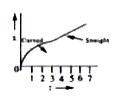A car starts from rest, accelerates uniformly for 4 seconds and then moves with uniform velocity . Which of the (x−t) graphs shown in fig. represents the motion of the car upto t=7s ?




The correct Answer is:D
To solve the problem, we need to analyze the motion of the car in two distinct phases: the acceleration phase and the uniform velocity phase.
1. Understanding the Motion Phases:
- The car starts from rest, which means its initial velocity u=0m/s.
- It accelerates uniformly for t=4s.
- After 4s, the car moves with a constant (uniform) velocity until t=7s.
2. Acceleration Phase (0 to 4 seconds):
- Since the car is accelerating uniformly, its velocity increases linearly over time.
- The final velocity v at t=4s can be expressed as:
v=u+at
where a is the acceleration. Since we don't know a yet, we can denote it as a.
3. Displacement during Acceleration:
- The displacement s during the first 4 seconds can be calculated using the equation:
s=ut+12at2
Substituting u=0:
s=12a(42)=8a
4. Uniform Velocity Phase (4 to 7 seconds):
- After 4 seconds, the car moves with a constant velocity v for 3s (from t=4s to t=7s).
- The displacement during this phase is:
s=v⋅t=v⋅3=3v
- Since v=4a (from the previous calculation), the displacement during this phase becomes:
s=3(4a)=12a
5. Total Displacement:
- The total displacement from t=0 to t=7 seconds is:
Total Displacement=8a+12a=20a
6. Graphical Representation:
- During the first 4 seconds, the graph of displacement vs. time (x−t) will be a curve that is increasing in slope (since the velocity is increasing).
- From t=4s to t=7s, the graph will be a straight line with a constant slope (since the car moves with uniform velocity).
7. Identifying the Correct Graph:
- We need to find a graph that shows an increasing slope from t=0 to t=4 seconds and a straight line from t=4 to t=7 seconds.
- Based on the analysis, the correct graph is the one that meets these criteria.
Conclusion:
After evaluating the options, we find that Option 4 is the correct representation of the car's motion up to t=7s.
- The car starts from rest, which means its initial velocity u=0m/s.
- It accelerates uniformly for t=4s.
- After 4s, the car moves with a constant (uniform) velocity until t=7s.
- Since the car is accelerating uniformly, its velocity increases linearly over time.
- The final velocity v at t=4s can be expressed as:
v=u+at
where a is the acceleration. Since we don't know a yet, we can denote it as a.
- The displacement s during the first 4 seconds can be calculated using the equation:
s=ut+12at2
Substituting u=0:
s=12a(42)=8a
- After 4 seconds, the car moves with a constant velocity v for 3s (from t=4s to t=7s).
- The displacement during this phase is:
s=v⋅t=v⋅3=3v
- Since v=4a (from the previous calculation), the displacement during this phase becomes:
s=3(4a)=12a
- The total displacement from t=0 to t=7 seconds is:
Total Displacement=8a+12a=20a
- During the first 4 seconds, the graph of displacement vs. time (x−t) will be a curve that is increasing in slope (since the velocity is increasing).
- From t=4s to t=7s, the graph will be a straight line with a constant slope (since the car moves with uniform velocity).
- We need to find a graph that shows an increasing slope from t=0 to t=4 seconds and a straight line from t=4 to t=7 seconds.
- Based on the analysis, the correct graph is the one that meets these criteria.
After evaluating the options, we find that Option 4 is the correct representation of the car's motion up to t=7s.
Similar Questions
A car starts from erest accelerates uniform by for 4 second and then moves with uniform velocity which of the x-t graph represent th motion of the car:-
View SolutionA car starts from rest and moves with uniform acceleration for time t then it moves with uniform speed of 60 km/h for time 3t and comes to rest. Find the average speed of car in its total journey.
View Solution
Knowledge Check
A car starts from rest moves with uniform acceleration a1 for t1 second and then retards uniformly at a rate a2 for t2 second. Then t1/t2 is equal to
Aa1/a2Ba2/a1Ca22/a1D2a1/a2
A car starts from rest and accelerates uniformly to a speed of 180kmh−1 in 10 s. The distance covered by the car in the time interval is
View SolutionA car starts form rest and accelerates uniformly for 10s to a velocity of 8ms−1. It then runs at a constant velocity an dis finally brought to rest in 64m with a constant retardation. The totla distance covered by the car is 584m Find the value of acceleration, retardation, and totl time taken.
View SolutionA car starts from rest and moves with uniform acceleration 'a', At the same instant from the same point a bike crosses with a uniform velocity 'u'. When and where will they meet ? What is the velocity of car with respect to the bike at the time of meeting?
View SolutionA car starting from rest accelerates uniformly to acquire a speed 20 km h−1 in 30 min. The distance travelled by car in this time interval will be :
View SolutionAs soon as a car just starts from rest in a certain dercation, a scooter moveing with a uniform speed overtakes the car. Their velocity-time graph is shown in . Calculate
 .
.
a. The difference between the distances travlled by the car and the scooter in 15s,
b. The distance of car and scooter from the starting point at that instant.
View SolutionA particle starts from rest and accelerates constantly with 2m/s2 for 10 s and then retards uniformly with same rate till it comes to rest. Draw the x-t, v-t and a-t graphs.
View SolutionStarting from rest, the acceleration of a particle is a=2(t-1). The velocity of the particle at t=5s is :-
View Solution